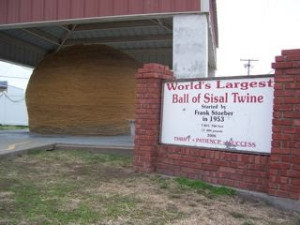
According to the Global Report Card that Josh McGee and I developed, tiny Waconda, Kansas is one of the top-performing school districts in the United States. Other than being the home to what residents claim is the world’s largest ball of twine (pictured here), one might not think that there was anything exceptional about this rural, farm community in north central Kansas.
But in 2007 the average student in Waconda performed better than 91% of students in our 25 country comparison group in math achievement. If we relocated Waconda to Finland, the average student in Waconda would outperform 88% of the students in Finland in math.
A reporter for Yahoo News was curious about what they were doing right in Waconda. Here is what she found:
So why are Waconda kids–65 percent of whom live in poverty–doing so well? And can other schools follow their lead?
The Waconda district comprises four small towns–Cawker City, Downs, Glen Elder and Tipton–and seven schools spread over 411 square miles. Most people in the area work in agriculture or in manufacturing.
The district’s superintendent of seven years, Jeff Travis, told Yahoo News that after years of high test scores, the community expects its students to excel. Most years, he added, no one drops out of high school. The district won 14 state Governor Achievement Awards and one national “Blue Ribbon Award School” over the past four years.
“It’s a tradition now, and they expect themselves to do well,” Travis said. “Like a ball team that continues to win because of a tradition, we have an academic tradition.”
Still, the community doesn’t quite seem to get how exceptional they are. “Everybody’s pretty happy [but] nobody understands how big a deal it is,” he said.
Travis says the students’ high level of achievement is even more extraordinary given that 65 percent of them qualify for free or reduced federal lunches, an indication that they live in poverty. High poverty schools are often dogged by low test scores and high dropout rates. Many educational observers indeed blame the nation’s sky-high child poverty level for the country’s comparatively low performance in math.
One theory Travis has is that Waconda school kids have no sense that they’re materially deprived. “North Central Kansas is rural, and urban poverty is kind of different [from] rural poverty,” he said. “A lot of our people don’t even understand that they’re living in poverty.” According to state data, most of the students are white, and no kids need English language learning classes.
About 10 percent of the students in the school district are foster kids, Travis says. “We just [have] a lot of adults that care about kids, so it’s been a popular thing for parents to take in foster children.”
But Josh adds a useful note of caution at the end of the reporter’s piece:
One of the Global Report Card’s authors, Josh McGee, says the small size of Waconda schools may have skewed the results slightly, since randomness has a greater impact on a smaller sample size. Most of the best-performing school districts in his ranking were small, and many of them were also made up of charter schools. You can read more about his methodology here.
We may not be able to generalize much from the success in Waconda, but it is a fun and impressive story.
Meanwhile, coverage of the Global Report Card continues to stream in. For an updated list of media for the Global Report Card (with links), click here.


